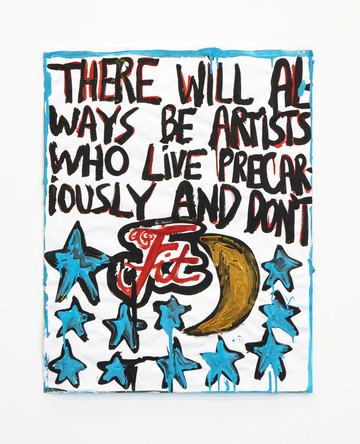
A queer cult figure in the Amsterdam art scene for nearly two decades, Dutch-American artist Sands Murray-Wassink (b. 1974, Topeka, Kansas) is a painter, body artist, writer and perfume collector indebted to various forms and permutations of intersectional feminist and queer art, with Carolee Schneemann, Hannah Wilke and Adrian Piper serving as key coordinates. As Murray-Wassink has moved in and out of institutional visibility over the years, his oeuvre of art and non-art objects has continued to grow.
Getting used to my handwriting etc. and my stream of thoughts, self acceptance. They are working through handwriting itself as something specific to the body (Hélène Cixous’s écriture féminine often comes up in conversation). They are also working through the thoughts, feelings and emotions involved in knowing that I’ll never have handwriting like Tracey Emin
Sands Murray-Wassink

Working 2010’s

Acrylic on paper
63 x 52 cm
24.8 x 20.4 in

Acrylic on paper
63 x 52 cm
24.8 x 20.4 in

Acrylic on paper
63 x 52 cm
24.8 x 20.4 in

Acrylic on paper
63 x 52 cm
24.8 x 20.4 in

Fabric Works

Acrylic on embroidered silk
98 x 68 cm
38.5 x 26.7 in

Acrylic on fabric
145 x 115 cm
57 x 45.2 in

Acrylic on fabric
90 x 53 cm
35.4 x 20.8 in

Acrylic on fabric
128 x 97 cm
50.3 x 38.1 in

Acrylic on pre-printed cotton
70 x 48 cm
27.5 x 18.9 in

Acrylic on linen
145 x 24 cm
57.1 x 9.4 in
In 1994, the then 20-year-old Sands Murray-Wassink left Brooklyn’s Pratt Institute, where he studied under Carolee Schneemann, for an exchange semester in Amsterdam. He continued his studies at one of the city’s lavish studio programs and never returned to New York. Listening to My First Phone Conversation With My Boyfriend (1996), I learn it was in this period that the Stedelijk Museum acquired his work and he met his partner Robin Wassink-Murray, with whom he has spent his life since.
Over the years Sands has produced an exhaustive amount of paintings, videos, performances, and texts, at once completely and unabashedly about him and at the same time about much more than himself—his loved ones,
his fellow artists, the artworld, the role of artists, and patriarchal society at large.
As we emerge from this moment of precarity and isolation and reconsider our ways of living and our ways of being with art, examining Murray-Wassink’s work feels timely as it puts emphasis on the influences, friendships and other relationships that inform an artist’s work, valuing process and messiness, feelings, emotions, and even the self- doubt and insecurities inherent to artistic practice and life.
As written by Titus Nouwens for The Brooklyn Rail in June 2021. Read the whole piece here.


